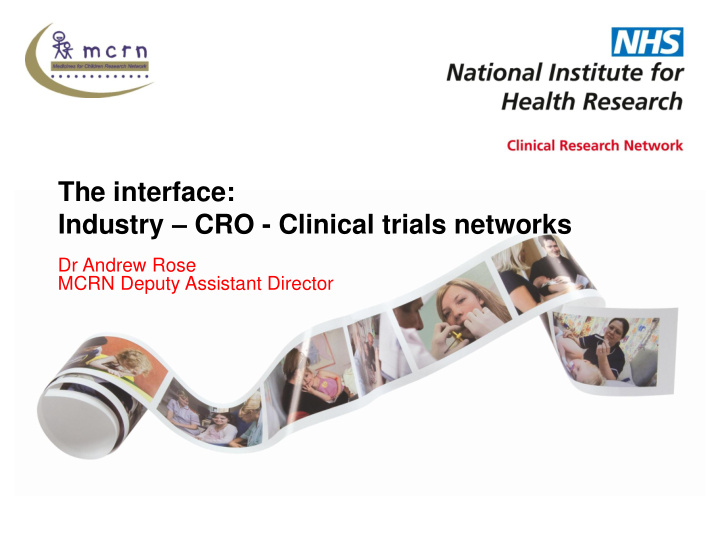



The interface: Industry – CRO - Clinical trials networks Dr Andrew Rose MCRN Deputy Assistant Director
Outline • Network services – Advice – Feasibility – Setup and recruitment • Network models • Strengths and weaknesses • Challenges • Conclusions
Advice • Scope – Protocols and programmes – EU Paediatric Regulation • Network organisation – Specialty Groups • Considerations/models – Perspective dependent on Network (Disease-specific, National...) – Early engagement between sponsor/CRO and Network is key – Charging? (Level of input from Network, link to experts...) – Patient involvement – What role does Enpr-EMA have in facilitating links?
Clinical Studies Groups (CSGs) Allergy, Infection and Immunity (BPAIIG) Dr Saul Faust Anaesthesia, Pain, Intensive Care and Cardiology Dr Mark Peters Cleft and Craniofacial Anomalies Ms Rona Slater Diabetes and Endocrinology (BSPED) Prof Timothy Barrett Gastroenterology, Hepatology and Nutrition (BSPGHAN) Dr Nick Croft General Paediatrics (including Dermatology) (BAGP) Dr Colin Powell Inherited Metabolic Disorders (UK LSD) Dr Chris Hendriksz Methodology Prof Ruth Gilbert Neonatal (Action Medical Research) Dr Mark Turner Nephrology (BAPN) Prof Moin Saleem Neurosciences Dr Timothy Martland Pain and Palliative Care (Louis Dundas Development Fund) New Pharmacy and Pharmacology Prof James McElnay Respiratory and Cystic Fibrosis Dr Paul Seddon Rheumatology (Arthritis Research UK) Prof Michael Beresford
Feasibility • Scope – Top-level review (Is the study going to work in particular country...) – Site identification – Support for sponsors/CROs/investigators when sites validated • Check feasibility/resources/costs • Network organisation – Regional structure of National Networks • Considerations/models – What do our customers want? Are we duplicating activities of CROs? – Delegation of activities to Networks (acting like CRO)/supporting CROs – Charging? (Level of service/information that Network can provide, loss- leader, link to experts...) – Enpr-EMA role?
Setup and Recruitment • Scope – So study can open and recruit successfully, need to facilitate: • Reg approvals, contracts, costs, resourcing, planning, training – Data monitoring • Network organisation – Staff structure to facilitate delivery/monitoring (hands-on or direction) • Considerations/models – Resources/staff availability often key (link back to feasibility) – Charging models - ensuring funds flow back to right place – Delegation of activities to Networks (acting like CRO)/supporting CROs • Monitoring to standards required?
Network models Sponsor Sponsor Sponsor Sponsor CRO CRO CRO Network Network Sites Sites Sites Sites Participants Participants Participants Participants Network Full responsibility Support for many roles
Network strengths and weaknesses • Strengths – Can be very effective at supporting activities • Provision of advice • Feasibility • Setup and Recruitment – Very effective at developing research infrastructure and expertise • Weaknesses – Can have limited scope – Variation • In what they provide • In the enthusiasm of members – Voluntary / good will – Limited funding – Competition with CROs (real or perceived)
Challenges for Networks • Investigators – Networks do not (always?) employ all investigators – Some investigators need to develop understanding of: • What is needed for industry studies • Benefits of a Marketing Authorization – Other factors • Culture of publicly-funded pragmatic trials (mainly post-marketing) • Industry priorities not always same as clinical priorities
Challenges for Networks • Study design – Some poorly designed studies – complexity • Capacity – Networks/sites/units/investigators • Barriers outside the control of Networks – Health care systems • hospital management etc – Ethics etc – Situation getting better, but some things cannot be influenced by Networks…
Conclusions • Networks want to deliver for sponsors and CROs • Different models are in operation across Networks • Early engagement, collaboration and communication are key • How can we all work with Enpr-EMA to overcome the challenges that we experience?
industry@mcrn.org.uk www.mcrn.org.uk
Recommend
More recommend